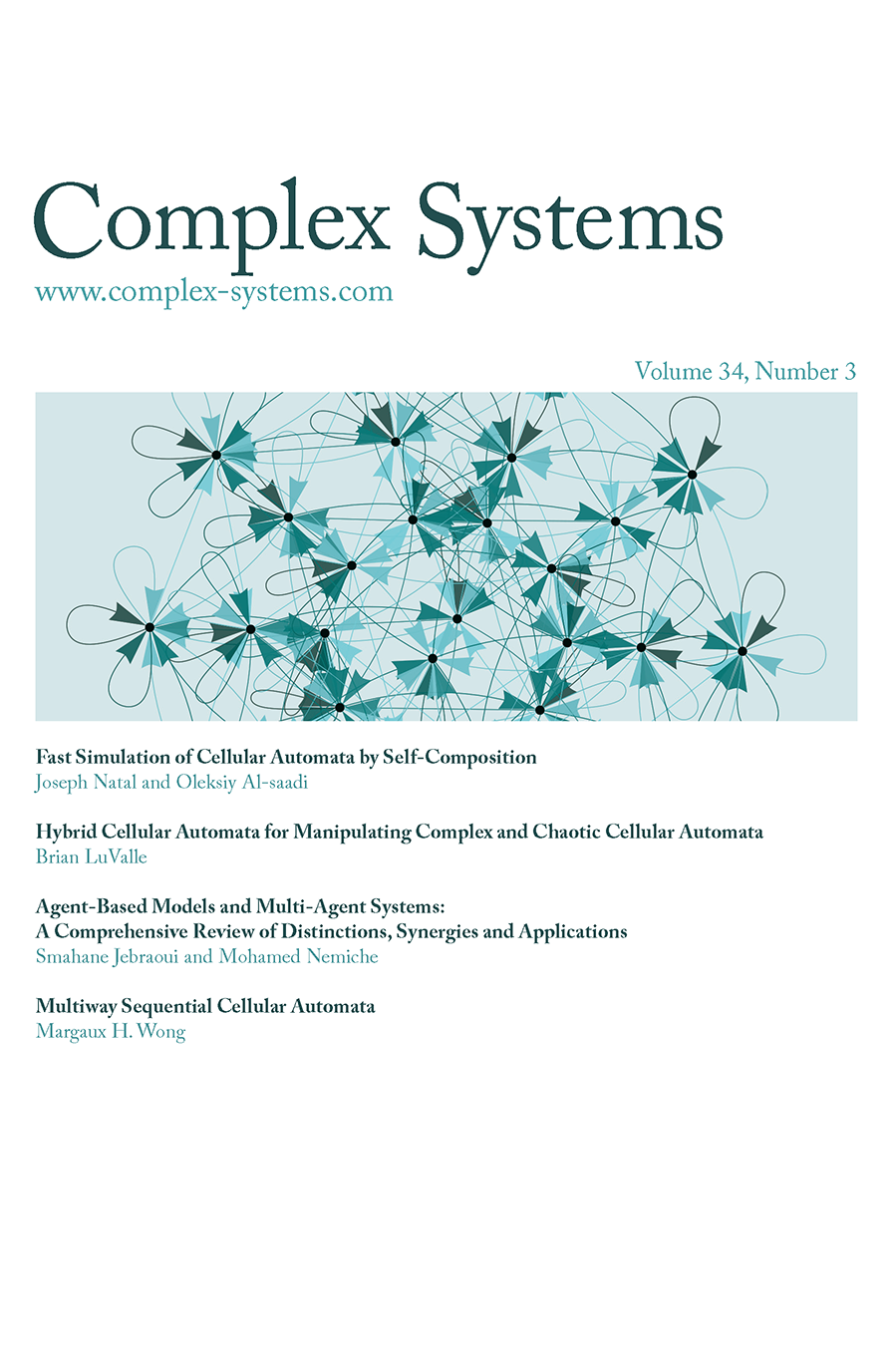

Volume 34, Number 3 (2025)
Fast Simulation of Cellular Automata by Self-Composition

Joseph Natal and Oleksiy Al-saadi
Computing the configuration of any one-dimensional cellular automaton at generation n can be accelerated by constructing and running a composite rule with a radius proportional to log n. The new automaton is the original one, but with its local rule function composed with itself. Consequently, the asymptotic time complexity to compute the configuration of generation n is reduced from -time to but with -space, demonstrating a time-memory tradeoff. Experimental results are given in the case of rule 30.
Keywords: cellular automata; time complexity; rule 30; nonlinear systems
Cite this publication as: J. Natal and O. Al-saadi, “Fast Simulation of Cellular Automata by Self-Composition,” Complex Systems, 34(3), 2025 pp. 259–271.
https://doi.org/10.25088/ComplexSystems.34.3.259
Hybrid Cellular Automata for Manipulating Complex and Chaotic Cellular Automata

Brian LuValle
Control of chaos methods have been successfully applied to many small, closed, chaotic systems; however, there is a difficulty in expanding them to be applicable to large, open, chaotic systems. In this paper, a novel method of manipulating chaotic systems using hybrid cellular automata is proposed and evaluated. Four experiments are performed. The first experiment examines hybrid cellular automata in the presence of perturbations to the initial conditions. The second experiment analyzes the relationship between the total number of perturbations and the certainty that hybrid states will change. The third experiment analyzes the reachability of hybrid systems using complexity measures. The fourth experiment analyzes how phase transitions are affected by high-impact hybrid schemes.
Keywords: control of chaos; cellular automata; hybrid cellular automata; reachability; block entropy; structural entropy; block decomposition method; algorithmic information dynamics
Cite this publication as:
B. LuValle, “Hybrid Cellular Automata for Manipulating Complex and Chaotic Cellular Automata,” Complex Systems, 34(3), 2025 pp. 273–298.
https://doi.org/10.25088/ComplexSystems.34.3.273
Agent-Based Models and Multi-Agent Systems: A Comprehensive Review of Distinctions, Synergies and Applications

Smahane Jebraoui and Mohamed Nemiche
The agent-based model (ABM) and multi-agent system (MAS) computational approaches have gained significant attention in various scientific disciplines. While these terms are sometimes used interchangeably, an ABM and an MAS share common principles, but they differ in their underlying philosophies, modeling approaches and applications. This review paper aims to elucidate the differences between the ABM and MAS approaches, highlighting their individual strengths and exploring the potential synergies. Understanding these distinctions is crucial for researchers and practitioners seeking to employ these approaches effectively in their respective fields.
Keywords: agent-based model; multi-agent system; agent behavior; modeling and simulation
Cite this publication as:
S. Jebraoui and M. Nemiche, “Agent-Based Models and Multi-Agent Systems: A Comprehensive Review of Distinctions, Synergies and Applications,” Complex Systems, 34(3), 2025 pp. 299–323.
https://doi.org/10.25088/ComplexSystems.34.3.299
Multiway Sequential Cellular Automata

Margaux H. Wong
Cellular automata (CAs) are used to model rule-based evolutionary systems with standard CAs applying unitary, fixed rules to an entire generation at a time. A sequential updating asynchronous cellular automaton (CA) with more than one rule for each input sequence is studied. These multiway sequential CAs (MSCAs) can model complex systems with multiple branching rule sets where changes propagate through the system. This paper examines the case of one-dimensional, two-cell, two-branch MSCAs in order to better understand their structure and the impact of parameters. The complete set of 1296 M-type rule sets possible for this type of multiway sequential CA (MSCA) is applied to a full set of 32 initial conditions, representing all possibilities of a six-cell initial condition, generating 41472 state graphs. Machine learning is used to classify a subset of these state graphs into 10 classes. Analytical data enables characterization of these classes of graphs and investigation of the role of rule sets in these state graphs. Target distribution analysis of the M-type rule sets is performed within each class of graphs to tease out intrinsic characteristics of the classes.
Keywords: cellular automata; multiway sequential cellular automata; MSCA; multiway systems; asynchronous cellular automata; nonhomogeneous cellular automata
Cite this publication as:
M. H. Wong, “Multiway Sequential Cellular Automata,” Complex Systems, 34(3), 2025 pp. 325–372.
https://doi.org/10.25088/ComplexSystems.34.3.325

Complex Systems ISSN 0891-2513
© 1987–2025
Complex Systems Publication, Inc.
Published four times annually
Complex Systems Publications, Inc.
P.O. Box 6149
Champaign, IL 61826 USA
Join the leading edge of complex systems research today. There are no publication charges. Authors are provided with 25 reprints of papers published in Complex Systems. Papers may be submitted via the web or email. Find out more »
